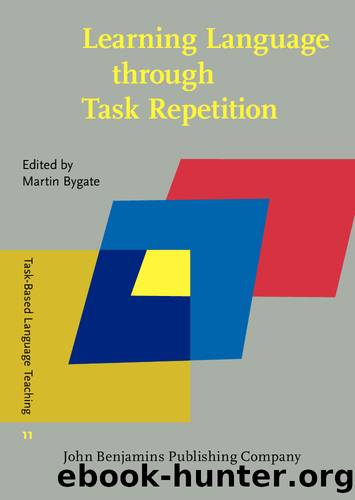Learning Language Through Task Repetition by Bygate Martin;

Author:Bygate, Martin; [Bygate, Martin]
Language: eng
Format: epub
Publisher: John Benjamins Publishing Company
Published: 2018-09-04T16:03:47+00:00
The above extract consists of AS-units containing only a fragmental non-clausal unit, where the two speakers were negotiating the location of a tree in their picture. It is worth noting here that while such detailed information was not essential either for the primary picture-sequencing task or for the LC post-task picture retelling activity, it was of importance for the HC speakers who needed to draw the pictures.
Performance criteria were also closely associated with speed-related fluency, with the HC speakers generating a higher MLR than the other two groups, although only the difference between the HC and LC dyads reached significance. As we know, HC performers tended to pack in more information at the phrasal level by using various forms of modifiers. Conceivably, the conceptualizing and encoding of more complex semantic content would consume a greater deal of processing capacity, leaving scarce attentional resources available to attend to other aspects of language use. Hence, it would be unusual if speakers could improve fluency (MLR) simultaneously. Towell et al. (1996) proposed that changes of MLR should be interpreted by taking into account other measures of fluency. They argued that speech rate is concerned with the conceptualisation process and that MLR is concerned with formulation. Under the conditions that the proportion of speech time remains unchanged or increases, and that the length of pause does not change or decreases, runs with increased length indicate that speakers can process more language or encode more information at a single time span, hence indicating greater proceduralization of knowledge. Longer MLR may also indicate that speakers have stored prefabricated language and can have quick access to these ready-made lexical chunks. Apparently, these two accounts for increased MLR are more closely related to the development of proficiency over a longer period of time. Pawley and Syderâs (1983, 2000) one-clause-at-a-time hypothesis might be more relevant here. That is, the HC speakers, in response to the task requirement, were somehow led to process more language and encode more information in a single clause, which might actually facilitate the observed higher MLR, rather hinder it. This implies then that Towell may be wrong â that differences in MLR do not reflect differences in formulation as opposed to conceptualization. In other words, differentiated conceptualization demands may also lead to differences in MLR.
Download
This site does not store any files on its server. We only index and link to content provided by other sites. Please contact the content providers to delete copyright contents if any and email us, we'll remove relevant links or contents immediately.
Cecilia; Or, Memoirs of an Heiress — Volume 1 by Fanny Burney(32320)
Cecilia; Or, Memoirs of an Heiress — Volume 3 by Fanny Burney(31699)
Cecilia; Or, Memoirs of an Heiress — Volume 2 by Fanny Burney(31675)
The Lost Art of Listening by Michael P. Nichols(7331)
Asking the Right Questions: A Guide to Critical Thinking by M. Neil Browne & Stuart M. Keeley(5545)
We Need to Talk by Celeste Headlee(5475)
On Writing A Memoir of the Craft by Stephen King(4797)
Dialogue by Robert McKee(4256)
Pre-Suasion: A Revolutionary Way to Influence and Persuade by Robert Cialdini(4069)
I Have Something to Say: Mastering the Art of Public Speaking in an Age of Disconnection by John Bowe(3805)
Elements of Style 2017 by Richard De A'Morelli(3268)
The Book of Human Emotions by Tiffany Watt Smith(3185)
Fluent Forever: How to Learn Any Language Fast and Never Forget It by Gabriel Wyner(2963)
Name Book, The: Over 10,000 Names--Their Meanings, Origins, and Spiritual Significance by Astoria Dorothy(2899)
Good Humor, Bad Taste: A Sociology of the Joke by Kuipers Giselinde(2845)
Why I Write by George Orwell(2840)
The Grammaring Guide to English Grammar with Exercises by Péter Simon(2668)
The Art Of Deception by Kevin Mitnick(2651)
Ancient Worlds by Michael Scott(2560)
